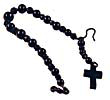
| Mourning and remembrance | Home |
 Mourning costume |
A widow could be in mourning
for her husband for up to 2½ years during the 19th century.
She dressed in deep mourning for a year and a day. Gradually the colour
of the clothes changed until the mourning period was complete. During periods of mourning men wore black bands around hats and sleeves. Bright buttons and buckles were replaced with ones of dull black metal. Wearing black or dark colours is still customary at Christian funerals. Muslims also wear black. Sikh and Hindu women wear white or pale colours during the period of mourning which can last up to a year. |
|---|
| Although the customs of wearing deep mourning dress gradually subsided
after the death of Queen Victoria in 1901 other practices have remained
important. Flowers continue to be important at Christian funerals. In the Hindu and Sikh faiths a garland of dried flowers is often placed around a photograph of the deceased. |
 |
 |
 |
Copyrights to all of the resources on this web site are retained by the individual rights holders.
They have kindly made their collections available for everyone to share and enjoy. Please respect
copyright.

